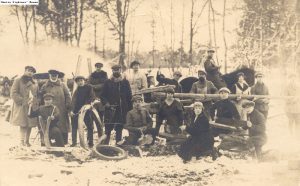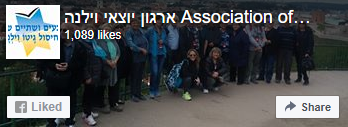Niemenczyn
 Niemenczyn (Nemenčinė) is located in what was under the Russian empire the 3rdOkrug (court distict) of the Uyezd (district) of Wilno (Vilnius), in the Guberniya (province) of Wilno (Vilnius). Its history seems to have mirrored that of Wilno (Vilnius), the dominant city of the region.
Niemenczyn (Nemenčinė) is located in what was under the Russian empire the 3rdOkrug (court distict) of the Uyezd (district) of Wilno (Vilnius), in the Guberniya (province) of Wilno (Vilnius). Its history seems to have mirrored that of Wilno (Vilnius), the dominant city of the region.
Niemenczyn (Nemenčinė) is first mentioned in 1338, when it and the Guberniya of Wilno (Vilnius) were still part of the pre-Christian Grand Duchy of Lithuania. The town was located at the foot of what is now called Górą Zamkową (“Castle Hill”) or Nemenčinės Piliakalnia (“Niemenczyn Mound”), on which the archaeological remains of a wooden castle of the 10th to 14th centuries can still be found. The castle directly overlooked the Niemenczynki(Nemenčia) river. Excavations on the mound were conducted by P. Kulikauskas from 1952-1954.
In 1387, shortly after his adoption of Christianity, Jogaila (Grand Duke of Lithuania and King of Poland) constructed a Catholic church in Niemenczyn (Nemenčinė), one of the first churches in Lithuania.
After the Union of Lublin in 1569, Niemenczyn found itself in the Polish-Lithuanian Commonwealth. Census records from 1569 list it among the royal estates.
The original church constructed by Jogaila burned in 1680, and was replaced by a newly-built church, which burned along with the rest of the city in 1842. The present stone structure, “St. Michael the Archangel”, was constructed in 1848-1855. It incorporates an antique organ previously in the Cathedral of Wilno (Vilnius).
Like many Polish towns, the town of Niemenczyn (Nemenčinė) was privately owned. From 1780 to 1803 Niemenczyn (Nemenčinė) was owned by the Bishop of Wilno (Vilnius). After 1803 it became the property the University of Wilno (Vilnius), which used income from the town to support retired professors of the school. After the dissolution of the university Niemenczyn (Nemenčinė) became the property of the Russian state.
Niemenczyn (Nemenčinė) was the location of a battle between Lithuanian and Imperial Russian forces during the Polish uprising against imperial Russia initiated by Tadeusz Kościuszko in 1794. On April 22, Jakub Jasiński led a 500-man Lithuanian force in an attack on the much stronger 3,000-man Russian barracks in Wilno (Vilnius). Some of the Russian soldiers were massacred, others fled. Some of the Russian forces, under the command of Lewis, re-assembled in the vicinity of Niemenczyn (Nemenčinė). There they were attacked by the Lithuanian army under Jasiński, and a battle ensued. The results of the battle at Niemenczyn (Nemenčinė) were indecisive, but the Lithuanian army succeeded for a time in keeping superior Russian forces in check. However, in July 1794, superior Russian forces marched on Wilno (Vilnius), and the uprising in Lithuania collapsed when Wilno (Vilnius) fell to these forces on August 12, 1794.
In 1795 the Guberniya of Wilno (Vilnius) passed to Russia in the third division of Poland, and was incorporated in the “Pale of Settlement” within which Jews were permitted to reside.
During Napoleon’s Russian campaign in 1812, he occupied Wilno (Vilnius) in an attempt to split the Russian forces under the command of Bagration and Barclay from each other. Napolean entered the city on the 28th of June, having crossed much of Russian Lithuania in just four days. He relied upon local foraging to feed his troops and pack-animals, leaving much devastation in his wake. The Russian forces retreated from the city, and Napoleon sent probing operations towards Niemenczyn (Nemenčinė) and other local towns. One of the French commanders, Joachim Murat, reached Niemenczyn (Nemenčinė) on July 1 and ran into the III Russian Cavalry Corps under the command of Doctorov enroute to Djunaszev. Napoleon mistook this force for the Russian 2nd army under the command of Bagration and rushed to do battle, only to learn of his mistake 24 hours later.
Niemenczyn (Nemenčinė) was again the scene of conflict during the “November Uprising” and “Russo-Polish War” of 1830-1831.
In 1842, virtually the entire town fell victim to fire, along with the local Catholic church that had replaced the church originally constructed by Jogaila. The present stone structure, “St. Michael the Archangel”, was constructed in 1848-1855. It incorporates an antique organ previously in the Cathedral of Wilno (Vilnius).
A location near Niemenczyn (Nemenčinė), in “Meschkanzi" (Meškonys), served as a point on the Struve Geodetic Arc, a chain of survey triangulations constructed by the German-born Russian scientist Friedrich Georg Wilhelm von Struve between 1816 and 1855 to establish the exact size and shape of the earth.
The Warsaw to St. Petersburg railroad line was built in 1861-1862 and passes just to the east of Niemenczyn (Nemenčinė). A railroad station, presumably built around the same time, is located in the nearby village of Bęzdany (Bezdonys). One may reasonably assume that a telegraph line was installed at the same time, although the earliest reference that I have been able to find to that telegraph line refers to 1908. Also introduced around 1865 was the kerosine lamp.
In 1908, Polish revolutionary forces conducted a raid on a Russian passenger and mail train at the Bęzdany (Bezdonys) rail station. The train was carrying tax revenues from Warsaw (capital of Poland) to St. Petersburg (capital of the Russian Empire). The future Polish national hero, Józef Piłsudski, personally led the attack, with 20 others participating as well. One Russian soldier was killed and five were wounded. The Polish national forces made off with somewhere between 200,000 and 300,000 rubles (about $100,000), which were then used to fund the Polish revolutionary forces.
During World War I, Wilno (Vilnius) and the surrounding region were occupied by German troops under Kaiser Wilhelm from 1916 to 1918. After the War Lithuania regained its independence and claimed Wilno (Vilnius) as its historic capital. However, Soviet troops invaded on Jan. 15, 1919. Newly-independent Poland drove the Red army out of Wilno (Vilnius) on April 20, 1919, but Soviet forces retook the city in the summer of 1920 and restored it to Lithuania. Then on Oct 9, 1920, Polish troops under General Lucjan Źeligowskidrove the Lithuanian troops out of Wilno (Vilnius), and Niemenczyn (Nemenčinė) was again incorporated into Poland.
Between WW I and WW II, the period of the Polish 2nd Republic, Niemenczyn (Nemenčinė) served as the home garrison for the Polish Border Protection Corps (Korpus Ochrony Pogranicza, KOP) Battalion “Niemenczyn”. This became part of the KOP Regiment “Wilno”, itself part of the 33rd Infantry Regiment, and took part in the defense of Wilno (Vilnius) and its vicinity at the start of World War II.
When Germany and Russia divided Poland in 1939, the Guberniya of Wilno (Vilnius) was occupied by Russian troops and on Oct 10, 1939 restored to Lithuania. Then, when the Soviets annexed Lithuania in June 1940, Russia again took control of the Guberniya of Wilno (Vilnius). Nazi troops invaded in 1941, and the Guberniya of Wilno (Vilnius) remained under German control until near the end of the war.
After World War II the Guberniya of Wilno (Vilnius) (including Niemenczyn [Nemenčinė]) were restored to Lithuania, now dominated by the Soviet Union, and Wilno (Vilnius) resumed its historic role as the capital of Lithuania. The town expanded considerably, and most of its current residents are newcomers who bear no relationship to the pre-WW II inhabitants of the town.
From: Sztetl


